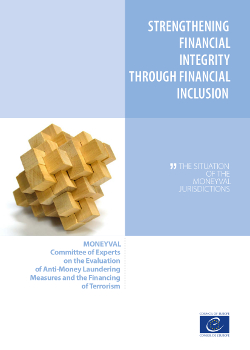Financial inclusion
The FATF Guidance on Anti-money laundering and terrorist financing measures and financial inclusion describes financial inclusion as providing access to an adequate range of safe, convenient and affordable financial services to disadvantaged and other vulnerable groups. This includes low-income, rural and undocumented persons, who have been underserved or excluded from the formal financial sector. Financial inclusion allows them to effectively manage their money, regardless of their level of income or social status. It also involves making a broader range of financial products and services available to individuals who currently only have access to basic financial products.
While their exact impact is not yet clear, financial inclusion policies and initiatives appear to constitute an important aspect of the fight against money laundering and terrorist financing. The AML/CFT global network is well aware of the fact that AML/CFT obligations may at some instances limit the access to financial services by some parts of the population, especially in countries with emerging markets which are still developing their financial system. A significant issue in this matter is a problem concerning the use of de-risking (for further information please see the section De-risking, where financial institutions instead of applying a risk-based approach prefer to refuse customers which could potentially bear a higher risk. These restrictions of access to formal financial services consequently lead to a more frequent recurrence to unregulated financial services, thereby avoiding the application of AML/CFT measures completely. In this respect, the FATF has stated that financial inclusion and AML/CFT initiatives pursue mutually supportive and complementary objectives. Consequently, the FATF ( together with other players of the global AML/CFT network) started a number of initiatives apply AML/CFT measures to an extent sufficient to protect the system from abuse by criminals, but at the same time to also enable access to financial services.
MONEYVAL undertook in 2014 an exercise to gather information on the levels of consideration of financial inclusion in its jurisdictions, the policies and measures in place to address these issues and the results, if any, of such initiatives. It also sought to identify steps taken by its States and territories to improve access to the formal financial system, and to identify barriers to financial inclusion. A questionnaire was prepared in this regard by the Secretariat. On the basis of the responses received from MONEYVAL States and territories, a report was drafted, presenting an overview of financial inclusion in MONEYVAL States and territories. At the occasion of the adoption of this report, MONEYVAL had the honour to welcome at its 45th plenary meeting (September 2014) Her Majesty Queen Máxima of the Netherlands, in her capacity as United Nations Secretary General´s Special Advocate for Inclusive Finance for Development, who addressed the Committee in this respect (full speech, photo gallery).
Reference documents

Strengthening Financial Integrity through Financial Inclusion (2014)
The report aims to establish the extent to which financial inclusion is currently taken into account by MONEYVAL states and territories. According to its conclusions, a number of states and territories have found a balance between a robust regime for combating money laundering and the financing of terrorism and the development of financial inclusion policies and procedures. They are also considering financial inclusion as an element in the development of their national risk assessments. The report draws the conclusion that financial inclusion policies and initiatives appear to constitute an important aspect of the fight against money laundering and terrorist financing. MONEYVAL states and territories are therefore encouraged to consider developing financial inclusion policies and initiatives and, in particular, to include a consideration of financial inclusion in their national risk assessments. MONEYVAL has decided to repeat this exercise every two years and will publish a further update in 2016.
- FATF Guidance 2013 – Anti-Money Laundering and Terrorist Financing Measures and Financial Inclusion
- GPFI Guidance 2011 – Global Standard-Setting Bodies and Financial Inclusion for the Poor: Toward Proportionate Standards and Guidance
- FATF Guidance 2008 – Guidance on Capacity Building for Mutual Evaluations and Implementation of the FATF Standards within Low Capacity Countries
Relevant Council of Europe websites
Conference of the Parties (COP) to the CETS 198



